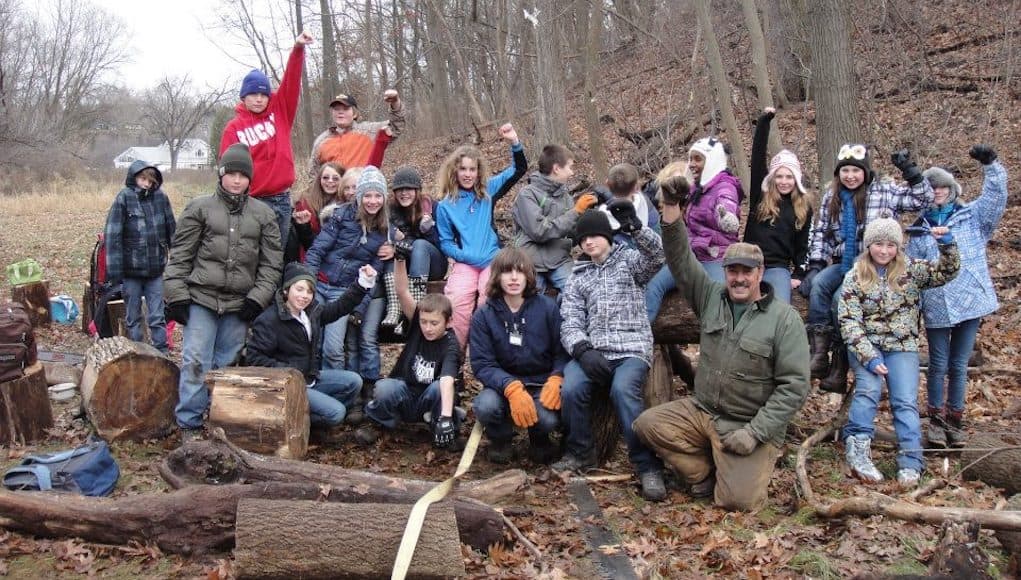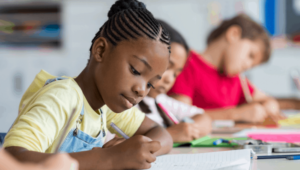Increase Student Motivation through Autonomy, Mastery and Purpose

By Victoria Rydberg
My two-year-old son loves to help. From hauling wood to making dinner, he prides himself on contributing to our family. My 88-year-old grandmother—despite her failing eyesight—strives to find ways to be of value to her condo community. At their environment-focused school, my middle school students blossomed as part of a classroom collective, enthusiastically sharing their talents. I believe that people, young and old, are at their best when they have purpose and are contributing value. Place-based education is one way for schools to help students make meaningful community contributions.
The Center for Place-based Education says that place-based education “focuses learning within the local community of a student. It provides learners with a path for becoming active citizens and stewards of the environment and place where they live. The resources of the community are brought into the learning process in a way that makes education exciting.” But in this era of accountability, while schools are struggling to simply engage students, should contributing to the community be a priority? Yes. In Drive: The Surprising Truth About What Motivates Us, author Daniel Pink outlines what is necessary for motivation: autonomy, mastery, and purpose. These three factors directly relate to engaging students and also contribute to retaining teachers. Place-based learning not only provides authentic opportunities to contribute to the greater good, it is also a vehicle to increase motivation. According to the Place-based Education Evaluation Collaborative (PEEC), “educators at sites using place-based education models consistently report that their students have become increasingly engaged and enthusiastic about learning.”
Autonomy
As students grow through developmental stages, they naturally assert independence. For toddlers, this can be as simple as “I do it myself.” In adolescents, independence often manifests as pushback and resistance. But when students are put in the driver’s seat for learning, instead of creating power struggles, educators help develop the autonomy students are seeking.
A high school in Oshkosh, Wisconsin offers a block-class called “Communities,” where all projects are rooted in the local community. Students work collaboratively to design and implement meaningful projects. This year students are identifying historic landmarks and developing self-guided tour materials. Past projects have included creating an outdoor classroom, building a hoop house for students to grow food, and implementing a school-wide a recycling challenge. [Several of these student projects are highlighted in this video.
When students design place-based learning projects, their motivation increases and teachers are empowered to guide the process—meeting the needs of learners and ensuring that learning targets are met.
Mastery
Often, students finish a curricular unit and never revisit that topic again. Although students may pass the unit test, have they developed a deep understanding of the content? When learning is rooted in a place-based approach, previous concepts are revisited and reinforced as students expand on projects and hone skills to work toward mastery.
At Fox River Academy in Appleton, Wisconsin, middle school students have been working on a community project for more than five years. Students literally stumbled upon a lost geologic and ecological treasure: the Pierce Park Ravine. Despite the fact that it was filled with trash and overgrown with undesirable species, the students and educators could see that this ravine held an important role in the landscape. Students made observations and gathered field data. They researched the history of the ravine, and studied historical maps. They interviewed neighbors. They gathered more field data—species inventories, soil types—and began cleaning up. The more they uncovered, the more there was to uncover. They discovered that a now endangered migratory bird once nested in the ravine. Students wrote a grant and received more than $60,000 to clean up trash, clear out brush and invasive species, restore habitat, design and construct trails, create signage, and hold an “open park” event.
During the past five years of this project, student groups have changed along with the subjects and standards. However, what has remained constant is the enthusiasm of team members working toward mastery. Students have focused on the successful outcome of the project, rather than a grade on a test. The restoration of a community treasure, the creation of an outdoor space for all to enjoy and the recovery of native species and wildlife activity in an urban area have all been proof of achieving outcomes. As the project continues, students continually ask themselves, “How can we do this better?” Students continue to maintain and improve the site each year and have learned the value of determination, tenacity and long-range visions.
Purpose
In rural southwestern Wisconsin, students and teachers in Highland Community School District find purpose in their education every day. This isn’t happenstance–this is by design. This farming community saw the need to keep young people connected and develop a place where they wanted to live and work after completing school. The school district revamped its entire structure and curriculum design to promote environmental place-based learning where students, from four-year-olds to seniors, have ownership of and are actively contributing to the greater community. Projects have included designing and constructing a rain garden (while learning mathematical concepts like slope) and helping the town get “Bird City” designation (while participating in citizen science data collection). These students know the purpose of their education, and never ask “when are we ever going to use this?”
At Northern Waters Environmental School, middle and high school students have partnered with their town board and DNR to develop solutions to community problems. At the local recreational forest, snowshoers and hikers were trampling ski trails. Students recognized the need to accommodate more recreational interests and designed and built more trails for snowshoers. At local handicapped accessible boat landing, students assessed the problem of runoff and then designed and constructed a rain garden to slow and filter the water entering the Chippewa Flowage. PEEC reports that participating in service-learning opportunities like these help “students feel empowered to continue making positive contributions to their community.”
These projects are fully integrated with learning English language arts, mathematics, science and social studies standards, and because these projects have purpose, students realize that what they learn matters and that each of them are key players in the project’s success.
Place-based learning can help schools reach accountability measures by increasing student motivation and providing an energizing teaching environment. When students and staff are engaged in contributing to the community, everyone wins.
This blog is part of our “Place-Based Education” blog series. To learn more and contribute a guest post for the series, check out the PBE campaign page. Join in the conversation on social media using #PlaceBasedEd. For more on Place-Based Education, see:
- Podcast | Outdoor Learning Leads to Curious Students
- Learning Leadership Skills Outdoors: Place-Based Ed in the Puget Sound
- Powerful School-Community Partnership Brings Learning to Life
- The Past, Present and Future of Place-Based Learning
Victoria Rydberg is a former middle school teacher and an education consultant in Wisconsin. Follow her on Twitter: @vrydberg
Stay in-the-know with all things EdTech and innovations in learning by signing up to receive the weekly Smart Update.







0 Comments
Leave a Comment
Your email address will not be published. All fields are required.